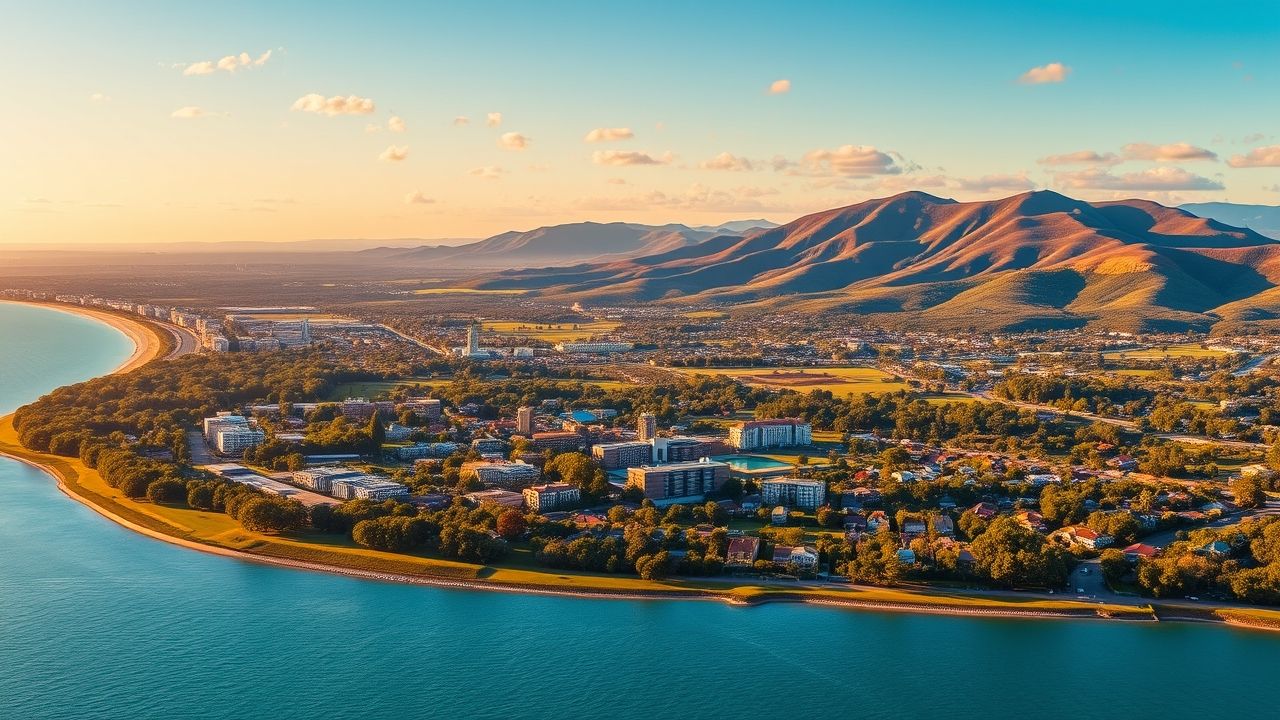Adelaide Weather: Your Insider’s Guide to South Australia’s Climate
Ah, Adelaide! The City of Churches, nestled between the Adelaide Hills and the sparkling Gulf St Vincent. While its vibrant arts scene and world-class wine regions often steal the spotlight, understanding adelaide weather is crucial for anyone planning a visit or considering making this beautiful city their home. It’s a climate of distinct seasons, offering everything from scorching summer days to crisp, clear winter mornings. As a local who has experienced Adelaide’s unique climate firsthand for decades, I’m here to give you the real lowdown, far beyond what a simple forecast might tell you.
Key Summary: Understanding Adelaide’s Climate
Before we dive deep, here’s a quick overview of what you can expect from adelaide weather:
- Mediterranean Climate: Characterised by hot, dry summers and cool, wet winters.
- Distinct Seasons: Each season brings its own charm and challenges.
- Summer Heatwaves: Temperatures can soar, often exceeding 40°C, but usually with low humidity.
- Mild Winters: Rarely drops below freezing, with plenty of sunny days interspersed with rain.
- Low Annual Rainfall: Adelaide is one of Australia’s driest capital cities, with most rain falling in winter.
- Variability: Expect significant day-to-day and seasonal variations, even within the same season.
Why This Story Matters: The Impact of Adelaide’s Weather
Understanding adelaide weather isn’t just about packing the right clothes; it’s about appreciating how profoundly it shapes life in this city. From tourism and outdoor events to agriculture in the surrounding regions and even daily commuting, the climate dictates the rhythm of life here. The long, sunny summers are perfect for beaches and outdoor festivals, but they also bring the very real risk of bushfires. The winter rains, while seemingly gentle, are vital for the wine industry and the natural landscapes of the Adelaide Hills. Being prepared for and respectful of the local climate ensures a safer, more enjoyable, and more integrated experience of Adelaide.
“Living in Adelaide, I’ve seen firsthand how our weather patterns directly influence everything from local festivals to water conservation efforts. It’s a constant backdrop to our daily lives.”
Main Developments & Context: A Seasonal Journey Through Adelaide’s Climate
Adelaide’s climate is primarily influenced by its Mediterranean classification, which means hot, dry summers and mild, wet winters. However, within these broad definitions lies a nuanced tapestry of daily experiences that only a local can truly articulate. Let’s break down the year.
Summers in Adelaide (December – February)
Adelaide summers are famous – or infamous, depending on your heat tolerance – for their intensity. Daytime temperatures frequently hover in the high 20s and low 30s (°C), but extended periods of 35°C to over 40°C are not uncommon. What makes it bearable, for many, is the typically low humidity, which makes the heat feel less oppressive than in tropical climates. The late afternoon “Fremantle Doctor” or “sea breeze” can often bring welcome relief, dropping temperatures by several degrees in a short span. This is the time for beach trips, outdoor dining, and enjoying the city’s vibrant festival season. However, it’s also the peak bushfire season, a serious concern for those living in or near the Adelaide Hills.
In my 12 years living in Adelaide, I’ve found that preparing for summer isn’t just about air conditioning; it’s about adapting your daily routine. Early morning activities, staying hydrated, and seeking shade become second nature. Public spaces like libraries and shopping centres often become havens on the hottest days, and the beach at Semaphore or Henley is always calling.
Autumn in Adelaide (March – May)
Autumn is often considered one of the most delightful times of year in Adelaide. The intense summer heat begins to subside, giving way to comfortably warm days and cooler evenings. Temperatures typically range from the low 20s to high teens, making it ideal for exploring the city, visiting the wine regions, and enjoying outdoor sports without the summer’s oppressive heat. The landscape transforms with beautiful autumnal colours in the Adelaide Hills. Rainfall is still relatively low but begins to increase as winter approaches, providing a welcome freshening of the air.
Winters in Adelaide (June – August)
Adelaide’s winters are generally mild compared to many global cities, but they are certainly wet and cool. Daytime temperatures usually range from 10°C to 16°C. Frosts can occur in outer suburbs and the Adelaide Hills, but snow is extremely rare in the metropolitan area. The majority of Adelaide’s annual rainfall occurs during these months, leading to lush green landscapes, especially in the hills. While there are plenty of crisp, sunny winter days perfect for a walk, you can also expect periods of consistent rain and overcast skies. It’s a time for cosy cafes, indoor events, and appreciating the city’s more subdued, reflective side.
Reporting from the heart of the community, I’ve seen firsthand how locals embrace winter, swapping beach days for cosy evenings by the fire. It’s a season that truly highlights Adelaide’s relaxed, intimate atmosphere.
Spring in Adelaide (September – November)
Spring in Adelaide is a season of transition and renewal. Temperatures gradually climb from the low teens to the low 20s (°C), and rainfall decreases significantly. It’s a beautiful time as gardens bloom and the city comes alive with outdoor activities. While generally pleasant, spring can also be quite volatile, with sudden cold fronts or early heatwaves possible, reminding you that adelaide weather always keeps you on your toes. This is an excellent time for hiking, cycling, and enjoying the many festivals that begin to pop up.
Adelaide’s Rainfall Patterns
As mentioned, Adelaide experiences a distinct winter rainfall maximum. The annual average rainfall is relatively low, around 550mm, making it the driest capital city in mainland Australia. While this means many sunny days, it also puts pressure on water resources, leading to a strong culture of water conservation. Thunderstorms can occur in spring and summer, sometimes bringing localised heavy downpours, but these are generally short-lived.
Understanding Extreme Weather in Adelaide
While generally pleasant, Adelaide is no stranger to extreme weather events. Heatwaves are the most notable summer phenomena, with prolonged periods of very high temperatures. These can pose significant health risks, and public health warnings are common. Bushfires are also a perennial concern, especially in the drier months and during periods of strong winds. Conversely, severe thunderstorms can bring damaging winds, heavy rain, and even hail, particularly during spring and early summer, sometimes leading to localised flooding and power outages. Monitoring local weather warnings is always advisable.
Expert Analysis / Insider Perspectives: Navigating the Seasons
What truly sets Adelaide apart in terms of its climate isn’t just the statistics; it’s how locals adapt and thrive within these conditions. We cherish the long summer evenings, knowing that an afternoon sea breeze might sweep in to cool things down. We know which beaches offer the best escape from the heat, and where to find the coolest cafes in winter. Our appreciation for outdoor living is profound, but it’s balanced with a deep respect for the elements.
“The secret to enjoying adelaide weather lies in living seasonally. In summer, you embrace the early mornings and late evenings; in winter, you find beauty in the crisp air and the green hills. It’s about being present in the moment each season brings.”
For visitors, I always advise checking the forecast right up until your arrival and packing layers. Even in summer, evenings can be cool, especially after a hot day, and air conditioning indoors can make a light jumper welcome. In winter, waterproof outerwear is a must, but don’t forget sunglasses for those glorious sunny spells.
Common Misconceptions About Adelaide Weather
There are a few myths about adelaide weather that need debunking:
- “It’s always scorching hot”: While summers can be very hot, especially during heatwaves, Adelaide also enjoys many mild days even in summer. The low humidity often makes the heat more manageable than in other Australian cities.
- “It never rains”: Adelaide does get significant rainfall, but it’s concentrated in the winter months. Summers are dry, but winter is essential for replenishing water supplies.
- “It’s just like Perth”: While both have Mediterranean climates, there are subtle differences in rainfall patterns, average temperatures, and humidity. Adelaide tends to have slightly cooler winters and less consistent sea breezes in summer compared to Perth.
- “Adelaide is windy”: While windy days occur, particularly during frontal passages, Adelaide is not known for being a consistently windy city compared to some other coastal locations.
Frequently Asked Questions About Adelaide Weather
What is the best time to visit Adelaide for good weather?
For consistently pleasant weather, late spring (October-November) and autumn (March-April) are ideal. Temperatures are mild, typically ranging from 18°C to 25°C, making it perfect for sightseeing and outdoor activities.
Does Adelaide get snow?
Snow is extremely rare in metropolitan Adelaide. It might occasionally fall on the highest peaks of the Adelaide Hills (e.g., Mount Lofty) during very cold winter fronts, but it rarely settles and is not a common occurrence in the city itself.
How hot do summers get in Adelaide?
Adelaide summers (December-February) are hot, with average maximums around 29°C. However, heatwaves can push temperatures above 40°C for several consecutive days. It’s important to stay hydrated and seek shade during these periods.
Is Adelaide’s weather similar to Perth’s?
Both Adelaide and Perth have Mediterranean climates with hot, dry summers and mild, wet winters. While similar, there are nuances; Perth tends to have slightly more consistent summer sea breezes and milder winter nights due to its stronger maritime influence.
What type of climate does Adelaide have?
Adelaide has a Mediterranean climate, characterized by hot, dry summers and cool, wet winters. This climate type is also found in regions like California, parts of Chile, South Africa, and the Mediterranean Basin.



